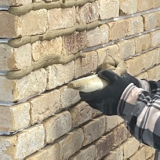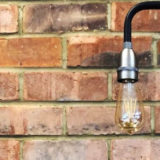Whilst efflorescence is rare on brick slip installation and only appears on a very small percentage of projects it is worth knowing what it is and how to remove it.
In short efflorescence on brick slips is the natural crystalline transition and deposit of salts that can form when moisture is present in the brick slip and substrate compound.
It has a white powdery tint and consists of mineral and salt deposits left behind when the water evaporates.
What actually causes Efflorescence in brick slip installation?
Water-soluble salts and minerals that are present in mortars, sands, cements and substrates are naturally transported through a process called osmosis through the brick slips.
This happens when both the brick slip and compounds still hold moisture. When the moisture eventually evaporates this causes the salts to crystallize, resulting in efflorescence.
Internally on brick slips
Internally efflorescence usually happens soon after installation when the internal heating dries the mortars and brick slips out fully.
Externally on brick slips
Externally efflorescence is usually a seasonal problem, and humidity will impact whether soluble salts appear. It usually escalates in winter, since rain, snow, sleet and other inclement weather conditions may arise. However, efflorescence can still occur in spring, autumn and summer.
Biggest causes of efflorescence
Sand and Cement are the biggest instigators of efflorescence.
Cement It is high in alkali and is more likely to efflorescence than other types of adhesive. Conversely, it is important to note that all types of cement contain some water-soluble alkali, making any cement susceptible to efflorescence.
Sand is another big cause of efflorescence as it is used in mortar and is not water-soluble. On the other hand, sand can be contaminated with a material that can contribute to efflorescence. For building projects, using clean, washed sand that comes from sources free of contamination will minimise the chance of efflorescence developing.
How to remove Efflorescence
Some of the best ways to remove efflorescence on brick slips include:
1) Pressurised Water: Applying pressurised water may dissolve efflorescence quickly. If you use water, dry off the water from the building material after application. If you fail to remove the water, crystals may remain that can cause efflorescence to reappear.
2) Diluted Vinegar: If you’re in a pinch, using household diluted white vinegar can be used on efflorescence. It’s less harmful than industrial chemicals and you most likely already have vinegar in your kitchen.
3) Brushing: With a strong brush, you can remove efflorescence with ease.
Removing efflorescence can be quick and simple. In fact, efflorescence on brick slips salts are water-soluble, which means efflorescence may disappear on its own due to normal weathering.
Important Note
To clean efflorescence off brick, it is crucial to complete this task in warm, dry weather. At this point, moisture may bring additional salts to the surface of brick, and the salts can be removed by dry brushing.



































